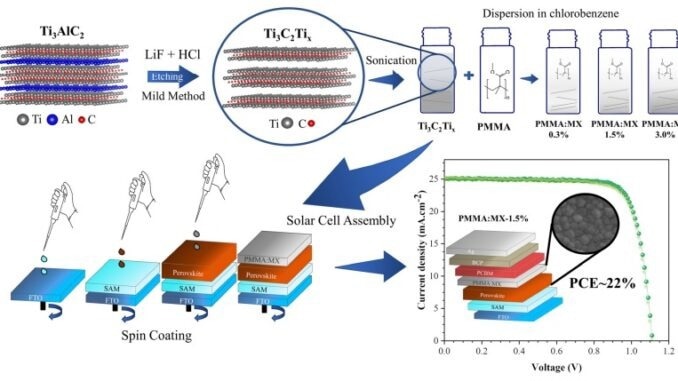In a study published in the Journal of Materials Chemistry C, Brazilian researchers present an approach for improving the efficiency and stability of solar cells that are made out of perovskite, a semiconductor material produced in a lab. The results of the study could be extremely beneficial to the future of the solar power sector.

The method developed at UNESP involves the use of a class of materials called MXenes. Image Credit: CDMF
Developed by researchers at São Paulo State University (UNESP) in Bauru, Brazil, the method makes use of a class of materials known as MXenes, a family of two-dimensional materials with a graphene-like structure combining transition metals, carbon and/or nitrogen, and surface functional groups such as fluoride, oxygen or hydroxyl.
Their properties include high electrical conductivity, good thermal stability, and high transmittance (relating to the amount of light that passes through a substance without being reflected or absorbed).
The MXene Ti3C2Tx was incorporated into polymethyl methacrylate (PMMA) to create a passivation layer in the study, which was then spin-coated over the perovskite layer of inverted solar cells. Passivation coatings are employed to help minimize possible defects in polycrystalline solids (perovskite in this case) as a result of interactions with the environment or with their internal structure.
The architecture, or arrangement of layers, is a critical factor in the performance of perovskite solar cells. To ensure great optical transparency when sunlight reaches the perovskite layer, the construction of an inverted solar cell is reversed.
The cells’ power conversion efficiency rose from 19 % to 22 % with the introduction of Ti3C2Tx. Additionally, compared to control cells (those without the passivation layer), the cells lasted three times longer with no loss in performance due to enhanced stability.
The results surprised João Pedro Ferreira Assunção, the study’s first author and a master’s candidate in UNESP’s graduate program in materials science and technology, as the project’s original goal was only to address the performance decline brought on by the addition of the insulating passivation layer.
Currently, the main focus of perovskite solar cell research is on developing large-scale industrial production methods that can produce stable, high-performance cells.
The article shows that addition of the MXene can be feasible under mass production conditions, and points to a way of achieving this. It also describes several electrical, morphological and structural characterization techniques that we explored to increase the scientific understanding of how this complex class of devices behaves and functions.
João Pedro Ferreira Assunção, Study First Author and Master’s Degree Student, Universidade Estadual Paulista
The study is a promising step toward the sustainability goals of producing clean energy, mitigating environmental impact, and making Brazil a leading industrial producer of solar cells, Assunção added.
Certain aspects of the research, including the material’s characterization through X-Ray photoelectron spectroscopy (XPS), were carried out at the Federal University of São Carlos (UFSCar)-hosted Center for Development of Functional Materials (CDMF), a Research, Innovation, and Dissemination Center (RIDC) supported by FAPESP.
Journal Reference:
Assunção, J. P.F., et. al. (2024) Interface passivation with Ti3C2Tx-MXene doped PMMA film for highly efficient and stable inverted perovskite solar cells. Journal of Materials Chemistry C. doi:10.1039/D3TC03810F